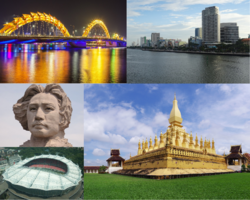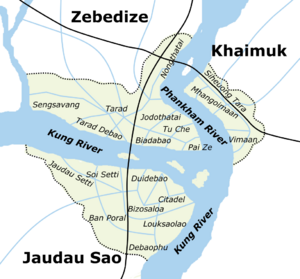Pers
This article is incomplete because it is pending further input from participants, or it is a work-in-progress by one author. Please comment on this article's talk page to share your input, comments and questions. Note: To contribute to this article, you may need to seek help from the author(s) of this page. |
Pers
ຄົນ Khon Zebedize | |
|---|---|
Capital city and metropolis | |
 Clockwise from top-left: Kung Financial District • Gogajedaiza • National Workers Stadium • Statue to Zadavana Goube • Yellow Dragon Bridge | |
| Country | Lavana |
| Province | Pers |
| Founded | ~6th century B.C.E. |
| Capital of Lavana | 1941 |
| Government | |
| • Body | City Council of Pers |
| • Party Secretary of Pers | Mainala Gobobudi (Lavanan Section of the Workers International) |
| Area | |
| • Land | 6,600 km2 (2,500 sq mi) |
| Elevation | 300 m (0–128 ft) |
| Population (2020) | |
| • Rank | 1st in Lavana (X in Coius) |
| • Urban | 8,122,521 |
| • Metro | 10,104,673 |
| Demonym | Persian |
Pers (Kachai: ຄົນ; Khon.Ziba: Zebedize ) is the capital city of Lavana, located in the Capital Province. With 22 districts, Pers, which is located in central Lavana, has an administrative area of 6,600 km2 (2,500 sq mi) and a total recorded population of 9,855,673 as of 2020. Nevertheless, its built-up (or metro) area encompassing the entirety of Pers province along parts of 6 Municipalities in 3 provinces is home to 10,704,673 people in the Pers Metropolitan area. Located within the Kung and Phankham rivers, Pers is the cultural, economical, and political centre of Lavana.
The name "Pers" is a Ziba name, coming from the city's historical origin from the conglomeration of Ban Sao, Khaimuk, and Zebedize, which are collectively known as the "Three Sisters of Pers". Pers lies at the confluence of the Kung river and its largest tributary, the Phankham River.
Pers traces its history back to the second century BCE, when Ban Sao (called Jaudau Sao) was established on the southern bank of the Kung river. Jaudau Sao was a major city during its period, being the capital of the Sayak and Dhijivodhi Empires. Following the burning of Jaudau Sao in 763, the city of Zebedize was established on the northern bank of the Kung river nestled against the Phankham in 765. A Kachai city called Khaimuk was established on the eastern bank of the Phankham in 944. During the 11th century CE, the Zebedize became majority Kachai. In 1280, Zebedize became the capital of the recently established Kachai Rasuvong Empire. Following its conquest by the Aguda Empire, it became an important administrative center, this lead to the resettling of Jaudau Sao in great scale. During the collapse of the Aguda Empire and subsequent Gaullican colonization, all 3 cities quickly depopulated losing an estimated 400,000 people in 60 years from 1820 to 1880.
On October 3rd, 1941 Pers became the capital of the Republic of Lavana, remaining as the capital under republican control during the civil war until becoming the capital of the People's Republic of Lavana on June 3rd, 1960 following its capture by Socialist forces. The city experienced large scale economic, and population growth. Between Independence and 1960 the city grew by 4 million people. The city saw significant fighting during the 2022 Lavana coup d'état.
The city hosts various venerable educational institutions and cultural venues of significance, including the National Museum, Yellow Dragon Bridge, National University of Pers, Gogajedaiza, National Workers Stadium, along with numerous ancient palaces and buildings.
Etymology
The name "Pers" comes from the three major cities on the banks of the Kung and Phankham Rivers that make up the Pers metropolis. It is unknown how the came to be used for the area, but its believed that its a Ziba translation to an earlier Kachai name used for the reason. In Ziba the name Zebedize, is favored rather than Pers, but its official policy to refer to the city as Pers, as thats the preferred name. "Zebedize" means "Zebedi go jaujevanauge zebedi jaudau ju"; the magnificent city higher than the high great river-junction.
In 1933 the 3 cities were combined into Pers, under Gaullican control, for easier administration. Following a recommendation by civil administrators. Upon independence the name Pers was specially used to serve as the official capital of Lavana, rather than any of its constituent cities. In 1961 the city of Jaudau Sao was renamed to the Kachai Ban Sao.
History
Early History
The city of Jaudau Sao on the south bank of the Kung River, was legendarily established on 452 BCE, however archeological excavations reveal the area to be inhabited for longer than the claimed date. The city quickly expanded becoming an important power in the region as it controlled the flow of trade in the Kung river, which connect large sections of the region. The city became the forerunner in Dhabovozuigi, although it increasingly relied on Ashinan mercenaries. Such mercenaries took control of the city on 33 CE, and established the Sayak Dynasty, ruling from Jaudau Sao. The Dhijivodhi Dynasty would be founded on the city following its capture in 109 CE. The city thrived under the Dhijivodhi Dynasty. Numerous Badi temples were constructed during this time most prominently Gogajedaiza in the 3rd century CE. It would lose its role as capital following the move of the capital towards Dezebenhua following the collapse of the Dhijivodhi in 470.
The city would be sacked burned in 763 at the end of the Zibinego Dynasty. With most of its buildings burned down, few buildings exist in their original state before the fire. Gogajedaiza was only saved by a timely rain, before its surrounding gardens could catch fire. The confluence of the Kung and Phankham remained inhabited and the city of Zebedize was established directly north of the burned Jaudau Sao, to maintain control of the river, although Zebedize would not be able to rival the glory days of Jaudau Sao. The city maintained a limited role in the regional economy, with the region falling under the auspices of Warlord Djai for most of the warring states period. In 944, a Kachai mercenary company settled on the east side of the Phankham and founded Khaimuk. The region was favored for settlement of Kachais do to fertile farmland, and strategic position. During the 11th century Zebedize is said to have become a Kachai majority city. The region featured the most concentrated population of Kachais all over the Gevuine Empire.
Colonial period
Transport
Highways and Expressways
Highways and expressways Numerous major highways and expressways pass through Pers, including:
Lavana National Highway 01
Lavana National Highway 02
Lavana National Highway 03
Lavana National Highway 22
K1 Pers–Ban Vuga Expressway
K2 Pers-Biyaosa Expressway
K3 Pers-Dezebenhua Expressway
K4 Pers-Karatau Expressway
Water Transport
Although much diminished from its past prominence, water-based transport still plays an important role in Pers and the immediate upstream and downstream provinces. Pers is the central hub for freight transported up and down the Kung river. With Lavana's largest inland port located in Ban Sao.
Several water buses serve commuters daily, with an estimated 144,425 daily passengers in 2010. Several long haul water buses exist with travel to major cities in Lavana via its river system, such as Ban Vuga, Biyaosa, Attapeu, and Sikeut. In 2014 a water bus capsized and killed 13 people, in the largest such incident in Lavana.

